THE ARCHITECTURE AROUND TRANSITION – AND JOY
Design is about balance and functionality, solving problems and, in the case of architecture and interior design, making spaces. Physical spaces. Spaces in which items are used and stored. Just as realtors stand face-to-face with people in the midst of their buying, selling, and moving processes—and dilemmas, challenges, even melt-downs—designers are often faced with helping people to create and renovate spaces that hold things. Objects, supplies, food, utilities, mechanical systems, tools, vehicles. You name it.
Architects also work hand-in-hand with people who have faced natural disasters or other circumstances in which they’ve lost their dwellings or have had to move suddenly. In these cases, designers must access more than their design brains; they must be humans helping humans. And as humans, we can utilize helpful approaches to how people organize their things. Recent trends can come in very handy when people become overwhelmed with the reality of populating their spaces.

For example, if you—whether you’re an architect, designer, business administrator, or private client—have missed the Marie Kondo phenomenon, you likely have been in a monastery meditating. But even if you’ve not seen even one episode of Tidying Up With Marie Kondo or read her books, The Lifechanging Magic of Tidying Up or the more recent Spark Joy: An Illustrated Master Class on the Art of Organizing and Tidying Up, you’ve still probably heard of minimizing. Or decluttering. Or maybe you caught an episode of the show depicting the dread of the alternative, Hoarders.
However the concept is framed, either you have too much stuff or you know someone who does. And if there’s a building or renovation project in the works, chances are that this stuff will have to be moved. But Marie Kondo has morphed the process into a more meaningful life change. There are plenty of websites and off-shoots in which Kondo’s practices are outlined, but the foundational ah-ha moment she has contributed is about joy. In a cascading process—starting with objects most easily sorted, such as clothing—a person touches each piece and senses whether it “sparks joy.” Of course, one can also consider usefulness, and whether something no longer fits, but leavening the utilitarian nature of decluttering with the joy factor changes everything.
And it complements the whole process of designing the future physical space of a person, a family, and even a forward-thinking company. When choosing utilitarian furniture for an office waiting area, must we choose colors that couldn’t spark joy for anyone? Does every cost-effective choice have to be joyless? It’s important to remember that homes are where we find our balance and work is where we spend most of our waking hours. These spaces have to include pleasure, from physical comfort to visual attractiveness to appropriate functionality.

Perhaps Marie Kondo’s categorizing concepts also can come in handy in the architecture field. She suggests considering our stuff in groups, from easier-to-consider to more intimate—clothes first, then books, papers (files, bills, notes), komono (miscellany, including everything from general supplies to kitchen, garage, bath, and décor items), and finally the sentimental. Her idea is that it’s hardest to sort photos, memorabilia, and heirlooms, and so it’s best to save these until last, when the “sorting muscle” has been exercised. When planning spaces, maybe this idea could help folks who are having “design block.” They might find it easier to begin with certain areas first, depending on the building’s use. Or for interiors, hit the living room, and end with the bedrooms or baths.
Marie Kondo has started a discussion in the United States that has caused some charities to put a moratorium on accepting donations—they’re just full to the brim with discarded things hoping to spark joy in new owners. But don’t let that stop you. Spark away!